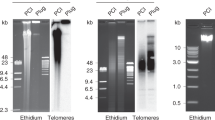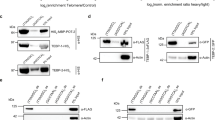Abstract
The ends (telomeres) of eukaryotic chromosomes must have special features to ensure their stability and complete replication. Studies in yeast1–3, protozoa4–6, slime moulds7,8 and flagellates8,10 show that telomeres are tandem repeats of simple sequences that have a G-rich and a C-rich strand. Mammalian telomeres have yet to be isolated and characterized, although a DNA fragment within 20 kilobases of the telomeres of the short arms of the human sex chromosomes has been isolated11. Recently we showed that a chromosome from the fission yeast Schizosaccharomyces pombe could, in some cases, replicate as an autonomous mini-chromosome in mouse cells12. By extrapolation from other systems1,3,13,14, we reasoned that mouse telomeres could be added to the S. pombe chromosome ends in the mouse cells. On setting out to test this hypothesis we found to our surprise that the telomeric probe used (containing both the S. pombe and Tetrahymena thermophila repeats) hybridized to a series of discrete fragments in normal mouse DNA and DNA from a wide range of eukaryotes. We show here that the sequences hybridizing to this probe are located at the telomeres of most, if not all, human chromosomes and are similar to the Tetrahymena telomeric-repeat component of the probe.
This is a preview of subscription content, access via your institution
Access options
Subscribe to this journal
Receive 51 print issues and online access
$199.00 per year
only $3.90 per issue
Buy this article
- Purchase on Springer Link
- Instant access to full article PDF
Prices may be subject to local taxes which are calculated during checkout
Similar content being viewed by others
References
Shampay, J., Szostak, J. W. & Blackburn, E. H. Nature 310, 154–157
Walmsley, R. W., Chan, C. S. M., Tye, B. K. & Petes, T. D. Nature 310, 157–160 (1984).
Sugawara, N. & Szostak, J. W. Yeast 2 (supp.) 373 (1986).
Blackburn, E. H. & Gall, J. G. J. molec. Biol. 120, 33–53 (1978).
Klobutcher, L. A., Swanton, M. A., Donini, P. & Prestcott, D. M. Proc. natn. Acad. Sci. U.S.A. 78, 3015–3019 (1981).
Ponzi, M., Pace, T., Dore, E. & Frontali, C. EMBO. J. 4, 2991–2995 (1985).
Johnson, E. M. Cell 22, 875–886 (1980).
Emery, H. S. & Weiner, A. M. Cell 26, 411–419 (1981).
Blackburn, E. H. & Challoner, P. B. Cell 36, 447–457 (1984).
Van der Ploeg, L. H. T., Lin, A. Y. C. & Borst, P. Cell 36, 459–468 (1984).
Cooke, H. J., Brown, W. R. A. & Rappold, G. A. Nature 317, 687–692 (1985).
Allshire, R. C. et al. Cell 50, 391–403 (1987).
Pluta, A. F., Dani, G. M., Spear, B. B. & Zakian, V. A. Proc. Acad. Sci. U.S. A. 78, 1475–1479 (1984).
Perrot, M., Barreau, C. & Bégueret, J. Molec. cell. Biol. 7, 1725–1730 (1987).
Cooke, H. J. & Smith, B. A. Cold Spring Harbor Symp. Quant. Biol. 51, 213–219 (1986).
Meehan, R. R. et al. Am. J. hum. Genet. 42, 26–37 (1988).
Gosden, J. R., Middleton, P. G., Rout, D. & De Angelis, C. Cytogenet. Cell Genet. 43, 150–153 (1986).
Liou, G. I. et al. Somat. Cell. molec. Genet. 13, 315–323 (1987).
Larson, D. D., Spangler, E. A. & Blackburn, E. H. Cell 50, 477–483 (1987).
Bernards, A., Michels, P. A. M., Lincke, C. R. & Borst, P. Nature 303, 592–547 (1983).
Pays, E., Laurent, M., De Linte, K., Van Meirvenne, N. & Steinert, M. Nucleic Acids Res. 11, 8137–8147 (1983).
De Grouchy, J., Turleau, C., Finaz, C. & Roubin, M. Chromosome Variation in Human Evolution (ed. Boyce, A. J.) 17–38 (Taylor & Francis, London, 1975).
Lejeune, J., Dutrillaux, B., Rethoré, M. O. & Prieur, M. Chromosoma 43, 423–444 (1973).
Yunis, J. J. & Prakash, O. Science 215, 1525–1530 (1982).
Sutherland, G. R. & Hecht, F. Oxford Monographs on Medical genetics 13, (Oxford University Press, 1985).
Henderson, E. et al. Cell 51, 899–908 (1987).
Greider, C. W. & Blackburn, E. H. Cell 51, 887–898 (1987).
Gilliam, T. C. et al. Cell 50, 565–571 (1987).
Author information
Authors and Affiliations
Rights and permissions
About this article
Cite this article
Allshire, R., Gosden, J., Cross, S. et al. Telomeric repeat from T. thermophila cross hybridizes with human telomeres. Nature 332, 656–659 (1988). https://doi.org/10.1038/332656a0
Received:
Accepted:
Issue Date:
DOI: https://doi.org/10.1038/332656a0
This article is cited by
-
Purification of mammalian telomeric DNA for single-molecule analysis
Nature Protocols (2022)
-
Targeting homologous recombination and telomerase in Barrett’s adenocarcinoma: impact on telomere maintenance, genomic instability and tumor growth
Oncogene (2014)
-
The telomere syndromes
Nature Reviews Genetics (2012)
-
Telomerase inhibitor GRN163L inhibits myeloma cell growth in vitro and in vivo
Leukemia (2008)
-
Telomeres and telomerase: the path from maize, Tetrahymena and yeast to human cancer and aging
Nature Medicine (2006)
Comments
By submitting a comment you agree to abide by our Terms and Community Guidelines. If you find something abusive or that does not comply with our terms or guidelines please flag it as inappropriate.



